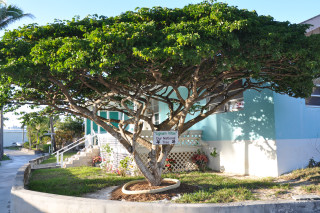Walt and I visited Man O War Cay aboard Windspell. Man O War Cay was originally settled by the
Albury family of Marsh Harbour. They had
purchased 50 acres from the crown in the early 1800s for agriculture. The story goes that while the father was
visiting the island with his daughter to till their garden, they heard
voices. When they went to explore on the
ocean side they discovered several sailors from a wrecked boat. The daughter fell in love with one of the
sailors who was from Harbor Island, near Eleuthera. They married and established themselves on
Man O War Cay. Many generations of that
family still live on the island today.
They have turned to boat building and repair and sail making. Walter & I walked the island from one end to the
other. Man O War Cay seems very conservative. Their homes are modest, the people very religous. The houses are very neat and tidy
with lovely gardens.
We sailed from there to Cormorant Cay where we had a lovely
secluded anchorage…the first anchorage we have had to ourselves since being in
the Bahamas! We dinghied to Snake Island
and explored a passageway behind several islands through shallow waters. A lumber industry was there back in the early
1900s. They harvested the island
pine/casuarina trees. When the trees
were gone in just a few years, the industry collapsed.
From there we
headed over to explore Hopetown.
Hopetown is known for its candy-striped lighthouse built by the British
in the mid-1800s. Back then, many of the
local people protested the building of the lighthouse, and attempted to
sabotage its construction since they made their living by “wrecking”…that is
going out to salvage shipwrecks off Elbow Cay reef. However, it was built and it remains today
just like it was then. The light burns kerosene, and the light rotates on a bed of mercury! We visited this lighthouse 28 years ago and
learned that it caused the lighthouse keepers to die from mercury poisoning
because the heat of the kerosene lamp vaporized the mercury. The lighthouse keepers were inhaling the
mercury vapour!
Today, Hopetown has beautiful little houses gaily painted in
a rainbow of pastel colours. Pickett
fences outline the properties and colourful flowering shrubs drape over the
fencing. Many of the homes are rental
properties. You can walk over to the
ocean side and stroll the beaches. There
is a little museum that did
a great job of describing the history of the area and portraying life as it was
back in the late 1800s and early 1900s.


















